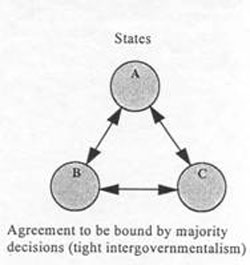Part 1: The Theory of Regional Trade Blocs
Cooperation
The nation state has been the primary actor in the global economy for hundreds of years. By definition, nation states are autonomous institutions with political sovereignty and self-rule. In reality, however, states are not quite so autonomous, for their success—and failure—often hinge on the conflict and cooperation they experience with other states. Historically, conflict has been the predominant interaction, but, following two devastating world wars, there has been increased emphasis on cooperation. Much of this cooperation has taken place via the establishment of intergovernmental organizations, such as NATO, the UN, the WTO, and the IMF, to name but a few. In the end, the success of intergovernmentalism rests on the willingness of member states to go along with majority decisions
of the group.
Beyond Cooperation
Cooperation between states does not imply a loss of political sovereignty. When states engage in interactions that lead to a loss of sovereignty, they have gone beyond cooperation, or intergovernmentalism, and are participating in supranationalism. This higher level of cooperation requires states to shift power and decision making to a supra-authority whose charge is to make decisions based on the welfare of the group as a whole.


The two most common supranational arrangements made between otherwise sovereign states are confederalist and federalist. Under a confederalist system the supra-authority exists solely at the discretion of the states. Under a federal system, the states and supra-authority coexist with shared and independent powers. In other words, confederalism involves a smaller loss of sovereignty to the states than federalism does.
Regional Integration
An increasingly common form of cooperation among states is the creation of regional trade agreements, such as NAFTA and the EU. Theoretically, there are five stages of regional integration, which are differentiated by the loss of sovereignty required of the member states. These stages, in increasing degree of supranationalism, include:
- Free trade area: the establishment of free trade in goods and services between the member states.
- Customs union: a free trade area plus the establishment of common external barriers to trade toward non-member states.
- Common market: a customs union plus the free movement of factors of production, such as capital and labor, among the member states .
- Monetary/economic union: a common market plus the harmonization of monetary policy, or establishment of a single currency, among the member states.
- Political union: a monetary/economic union plus the establishment of common foreign policy and civil laws among the member states .
Animation: Use this link to view a graphic representation of Regional Integration.
Pros and Cons of Regional Integration
There are many theoretical advantages and disadvantages that come with regional integration, most of which are exaggerated as the integration deepens. The advantages include:
- Decreased chance of conflict and war.
- Larger market and consumer pool exploits economies of scale.
- Freedom of movement of goods and peoples.
- Increased global significance.
- Pressure slackers to rise to the standard (e.g. environmental laws).
- Promotes democracy in less stable states.
- Trade creation—the elimination of protectionism increases trade, leading to a more efficient allocation of member state resources.
The disadvantages include:
- Loss of sovereignty, independence, and national identity.
- Loss of national power in favor of even bigger government.
- Increased competition causes job losses in some domestic industries.
- Loss of border control increases smuggling.
- Uniform laws don't account for cultural differences.
- Trade diversion—the elimination of trade barriers among the member states may divert trade away from more efficient non-member states that are disadvantaged by the protectionism they still face.


